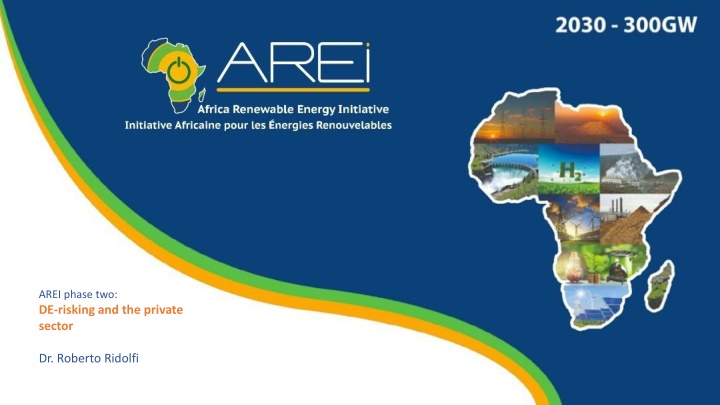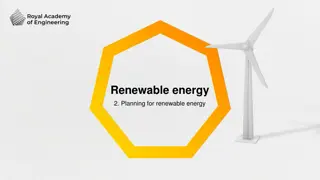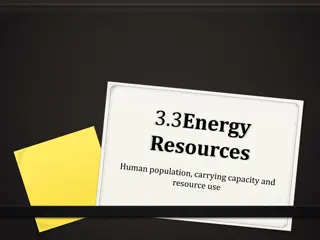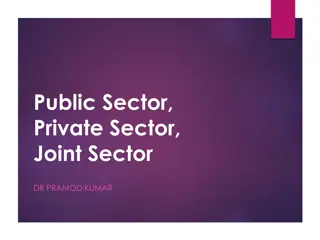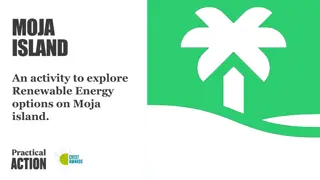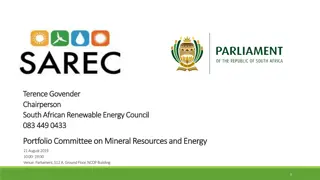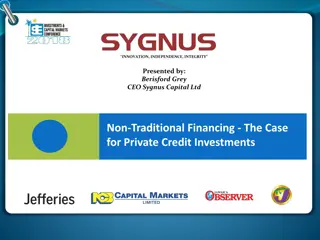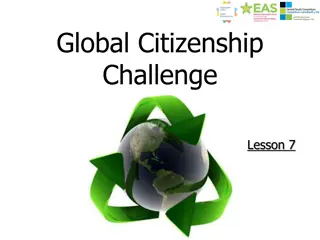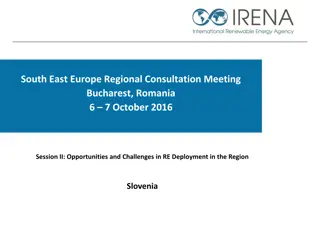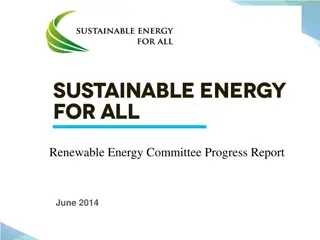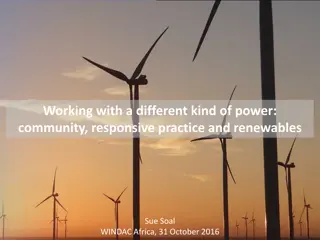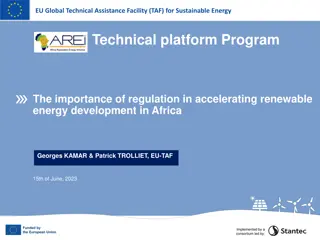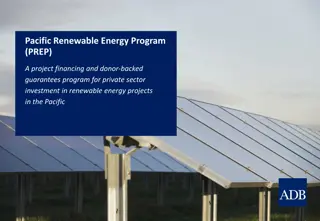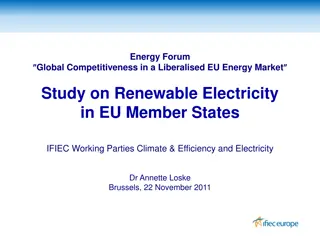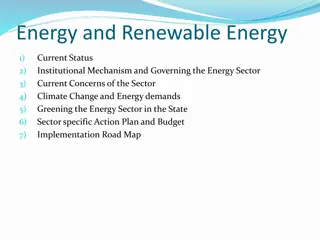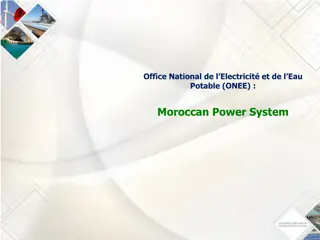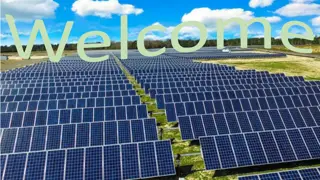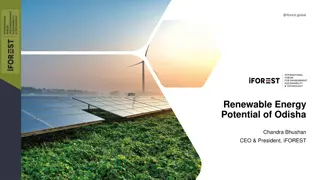De-risking for Private Sector Investments in Renewable Energy
Conclusions and recommendations from the AREI Forum highlight the importance of de-risking strategies to facilitate private investments in Renewable Energy in Africa. The report emphasizes identifying market challenges, understanding country-level risks, and promoting domestic resource mobilization for sustainable energy solutions.
Download Presentation

Please find below an Image/Link to download the presentation.
The content on the website is provided AS IS for your information and personal use only. It may not be sold, licensed, or shared on other websites without obtaining consent from the author.If you encounter any issues during the download, it is possible that the publisher has removed the file from their server.
You are allowed to download the files provided on this website for personal or commercial use, subject to the condition that they are used lawfully. All files are the property of their respective owners.
The content on the website is provided AS IS for your information and personal use only. It may not be sold, licensed, or shared on other websites without obtaining consent from the author.
E N D
Presentation Transcript
AREI phase two: DE-risking and the private sector Dr. Roberto Ridolfi 1
AREI phase two: de AREI phase two: de- -risking for the private sector risking for the private sector AREI phase two: analysis and reduction of risks is essential to facilitate private investments in Renewable Energy in Africa Conclusions and recommendationsof AREI Forum July 2022 Private sector approach: market challenges risks and returns Understanding and defining country-level risks Understanding and defining project risks (to be analysed in conjunction with project preparation ) 2
AREI phase two: De AREI phase two: De- -risking Conclusions 1/4 risking Conclusions 1/4 AREI may and shall: assist countries to identify the most relevant market challenges via studies and peer to peer: Inefficiencies in governance of the sector and implementation of policies. Fitness of business environment. Fitness of competition and project procurement rules. Financial sustainability of public off-takers. Fitness of market structure, legal framework, currency issues. coherence and transparency of energy regulations regarding private sector participation. general lack of legal and technical capacities in local institutions to efficiently manage project phases, from preparation to operation 3
AREI phase two: De AREI phase two: De- -risking Conclusions 2/4 risking Conclusions 2/4 assist governments using peer to peer approaches and examples from African countries complemented by technical assistance: to display a strong and long-term commitment tothe advancement of renewable energy solutionsand necessary energy policy reforms. stabilise national legal and regulatory frameworks avoidingretroactive changes that would impactbusiness models stability of projects in drafting consistent and reliable energy planning methodologies, based on technical capabilities, to support an appropriate energy mix and ensurepredictability ofcountry s strategic choices. ensure independent capable energy regulatory bodies responsible for good governance of electricity marketsand their implementation (i.e.,market rules, license issuing, grid codes,etc.). to make clear to investors which different authority in a country is responsible for which different risk. In this report the various risks were attributed not in general to the public or to governments but specifically to different ministries or agencies. 4
AREI phase two: De AREI phase two: De- -risking for the private sector risking for the private sector 3/4 3/4 Promote Domestic resource mobilization at the highest political level to those opportunities exist and to push for: Fiscal/budget allocation to the RE/EE sector Potential energy efficiency-related savings Domestic and regional green bonds Pension assets: African political and financial authorities should consider reforms and laws aimed at allowing their public pension funds to invest directly in Africa. Regional/intra-African FDI 5
AREI phase two: De AREI phase two: De- -risking for the private risking for the private sector 4/4 sector 4/4 1.assist in the training of officials and dissemination of best practices to analyse and understand project risks in public bodies and agencies 6
Derisking Derisking linked to SDGs: Agenda 2030 as a strong driver linked to SDGs: Agenda 2030 as a strong driver for AREI: the rationale for AREI: the rationale Policy sdg driven incentives Pay as you go Fee for service Crowd funding Public-private partnerships Innovative financing models Combine business plan of renewable energy supply with demand Smes can produce Young people get access to markets Demand creates better business models Comprehensive cost/benefit analysis (financial, economic, environmental , social and gender) Help assess investors risks and opportunities Go beyond financial aspects Tackling: SDG 7 to have impact on many more sdgs 7
AREI phase two: De AREI phase two: De- -risking for the private sector risking for the private sector Some market challenges are preventing the further scale-up of IPPS: an inefficient governance of the sector and implementation of policies. an unfriendly business environment, most notably for foreign investors. a lack of transparent competition and project procurement rules. a weak financial sustainability of public counterparts to offtake energy high-perceived risk environment linked to perspective investors perception of efficiency and reliability of the project-hosting country on market structure, legal framework, currency issues. coherence and transparency of government policies and regulations regarding power sector governance and private sector participation. soundness of sectorial development plans and project procurement rules. weak financial sustainability of public counterparts (off-takers). general lack of legal and technical capacities in local institutions to efficiently manage project phases, from preparation to operation 8
De-risking is essential Pressure from investors and shareholders for increased disclosure and transparency about sustainability in company reporting will drive investors to hold companies accountable. The financial segment can drive due diligence processes and methodologies, including certification to reduce system costs and encourage standardization towards SDGs. The tools conceived for business will have the same metric of certification, validation schemes to be used in loan appraisal and investment design. Indexes will be based on the same metrics too. However, we know that the pure private financial sector will not take any more risks tomorrow than those that they are ready to take today . For this reason, we need to connect the blended finance techniques and the development banks world to the commercial finance in a way that is instrumental to the policy incentives and the schemes that public authorities will decide to implement. 9
AREI phase two: Elements for a strategy : AREI phase two: Elements for a strategy : private sector on sustainable finance private sector on sustainable finance SUSTAINABLE INVESTMENTS The DEVELOPMENTOFANEW ECOSYSTEMis necessary policy alone will not be sufficient. towards INVESTMENT PUSH The centrality of finance institutions and commercial banks is crucial to enhance sustainable investments move beyond L IMPULSION POLITIQUE Impact investing Benefit-driven business models Creation of enabling environment
Institutional framework risks of countries The diversity of countries andthe different political structures and approachesmake it hard to propose a single framework. However,there are some common and fundamentalaspects: governments and public institutions to display a strong and long-term commitment tothe advancement of renewable energy solutionsand necessary energy policy reforms. national legal and regulatory framework to be stable, clear, and transparent, avoiding retroactive changes that would impactbusiness models stability of projects. consistent and reliable energy planning methodologies, based on technicalcapabilities, to support an appropriate energy mix and ensurepredictability ofcountry s strategic choices. independent capable energy regulatory bodies responsible for good governance of electricity marketsand their implementation (i.e.,market rules, license issuing, grid codes,etc.). energy planning institutions dedicated to identifying the necessary investments to meet the projected demand at the lowest cost. 11
AREI has carried out a study in MAY 21 on the uptake of policies (general RE policies not for private sector investments) Table Uptake of Renewable Energy / Energy Efficiency Policies by African Countries Uptake of Renewable Energy / Energy Efficiency Policies by African Countries Countries with high uptake of RE/EE policies Countries with high uptake of RE/EE policies (Number of policy instruments adopted in bracket) High uptake of RE/EE policies: Angola (5) High uptake of RE/EE policies: Kenya (8), Rwanda (6), Tanzania (8), Uganda (5) On-course towards high uptake of policies: Ethiopia (4) High uptake of RE/EE policies: Algeria (6), Egypt (7), Morocco (5), Tunisia (7) Lesotho (8), Malawi (8), Mozambique (6), South Africa (8), Zambia (6), Zimbabwe (5) High uptake of RE/EE policies: Burkina Faso (6), Cabo Verde (7), Ghana (10), Mali (5), Mauritius (6), Madagascar (4), Nigeria (7), Senegal (7), Mali (5) On-course towards high uptake of policies: C te d Ivoire (4),Liberia (4),Niger (4) Countries needing improvements in uptake of Countries needing improvements in uptake of RE/EE policies RE/EE policies (Number of policy instruments adopted in bracket) Burundi (2), Cameroun (3), CAR (1), Chad (1), DR Congo (2), Eritrea (2), Rep. of Congo (2) Comoros (2), Djibouti (2), Sao Tom (2), Sudan (3), Somalia (1), South Sudan (1) Central Africa Central Africa East East Africa and Africa and Indian Ocean Indian Ocean North Africa North Africa Libya (3), Mauritania (2) Southern Africa Southern Africa Eswatini (2) West Africa West Africa Benin (3), Gambia (3), Guinea (3), Guinea Bissau (3),), Sierra Leone (2), Togo (3) 12
I start de I start de- -risking Which Which ministry ministry and on investment dossier investment dossier is is blocked risking if if I know and on which I know where which desk blocked? ? where are the risks. are the risks. desk my my energy energy Investors need to know which different authority in a country is responsible for which different risk Various ministries hold the following risks: Land rights Local labour content Technology transfer requirements Licensing/permitting Host country law imposed for dispute resolution Investment laws 13
Understanding and defining country- level risks The Ministry of finance, fiscal agencies, and the central bank hold the following risks: Investment laws Import duties Withholding taxes Foreign exchange: availability, convertibility and transferability 14
Understanding and defining country-level risks Ministry of energy and/or authorities emanated from it such as regulators utilities agencies etc, hold the following risks: Generation-intermittency Transmission-connectivity Distribution-payment collection We need RE /EE institutions able to perform the work. 15
AREI phase two: risks directly linked to the AREI phase two: risks directly linked to the project project Before the project materialise, we have the fundamental issue of procurement. How many MWs are to be installed? By when? What is the process to procure them? The adoption of a transparent and, as much as possible, competitive procurement procedure to allow governments to procure the best infrastructure at the least cost, and to allow project developers to benefit from the advantages of a common and level playing field can reduce the procurement risks. PPPs policies are as good as the people posted to implement them. Fine lawyers, fine financial and technical specialists in the negotiating role are desperately needed and to a certain extent they must be in-house. In procurement the value chain of energy needs to be defined. How the MW will be evacuated? Transmission lines, sub-stations, and a grid that can evacuate energy without destabilization or cuts. The case of Turkana wind project in Kenya has demonstrated this. Guidelines for successful PPP implementation, European Commission, 2003 edit. R Ridolfi https://ec.europa.eu/regional_policy/sources/docgener/guides/ppp_en.pdf 16
AREI phase two: execution risks AREI phase two: execution risks The private sector holds the following risks (some of them must be hedged completely if we want to see the project to materialise) We distinguish during construction: Cost overruns Delays Performance shortfall Expropriation/nationalization risk Site selection risk Land dispute risk A way to address the execution risks is an EPC contract (engineering/procurement/ construction) that envisages penalties andliquidated damages for a delay in the construction or cost overruns and ensures thatthese risks are totally or partially transferred from the project to the EPC contractor. 17
AREI phase two: De AREI phase two: De- -risking project risks risking project risks During management we have different risks: Expropriation Nationalization Strikes Riots War Sabotage & terrorism A good quality PPA contract to define and secure project revenue streams, typically requiring the off takerto buy all or most of the electricityproduced at a pre-determined price can reduce these risks. 18
AREI phase two: a good PPA AREI phase two: a good PPA Some forms of indexation, either to a hard currency and/or to inflation, to ensure theadequacy of revenue streams defined by the PPA may reduce the currency risk further. Contractual provisions, also considered inside the PPA structure, must deal with some other important risks, such as curtailment compensation, force majeure (typically exempting both parties from their obligations for a limited period) and termination (covering the default risk from either the off-taker or the generator side). Risks within the off taker of the PPA: Revenue flow Off-taker creditworthiness/payment risk Termination payment risk 19
AREI phase two: the core of the problem: OFF AREI phase two: the core of the problem: OFF- - TAKERS TAKERS OFF-TAKERS Publicutilities in Africa face a multitude of challengeswhich undermine their financial stability. One way of addressing this is for governments to provide public counter-guarantees on the off-take payments. Risks with lenders Debt Foreign exchange Availability risk Convertibility risk Transferability risk In many African countries, strong political direction, and budgetary/fiscal allocations to the sector, via renewable access energy funds are critical and are one of the most important objectives of AREI phase 2. 20
The lesson from the analysis of existing de-risking schemes and tools is that we need one stop shop where all these are offered. Otherwise, different procedures by donors and lenders, different timing different political priorities will make the project derailing. Some practical principles that must direct actions emerge as conclusions from the analysis and understanding of project related risks. (i) project risks are typicallybest addressed by those entities mostsuited to bear and manage them, (ii) (ii)finding appropriate risk coverage isclearly fundamental to the ultimate success or failure of a project, successfully achievingthis will also require a high degree of collaborationand cooperation amongst all projectstakeholders (iii)effective and locally fit-for-purpose risk mitigation products and de-risking instruments will be fundamental to build other success stories. The provision ofthese products and instruments can then createthe market conditions for more attractive risk/reward profiles, helping to shift an unattractive investment opportunity into a commercially attractive one in the minds of private investors 21
Investment push policy pull and .money Investment push policy pull and .money Blending :How to move on? An example the European Investment Plan: Three Pillar Approach 22
EU-External Investment Plan Pillar 1 - Resources from EU and leverage 23
AREI PHASE TWO: THE PUBLIC ACTION TO MOBILISE AREI PHASE TWO: THE PUBLIC ACTION TO MOBILISE PRIVATE INVESTMENTS PRIVATE INVESTMENTS Structured dialogue with business Structured dialogue with business Structured dialogue with business Policy and political dialogue within African Policy and political dialogue within African Policy and political dialogue within African countries countries countries countries countries countries - United voice for the local private sector advocacy, networking and exchange of information - Informed policy dialogue on the business environment - Business fora - important partners in supporting partner country development AND the partnerships of foreign AND the partnerships of foreign - United voice for the local private sector advocacy, networking and exchange of information - Informed policy dialogue on the business environment - Business fora - important partners in supporting partner country development - United voice for the local private sector advocacy, networking and exchange of information - Informed policy dialogue on the business environment - Business fora - important partners in supporting partner country development AND the partnerships of foreign businesses businesses businesses - Enable business to operate formally, increase the level of investment and innovation, encourage the creation of investment and innovation, encourage the creation of - Enable business to operate formally, increase the level of - Enable business to operate formally, increase the level of investment and innovation, encourage the creation of jobs jobs jobs - Reducing business costs - Reducing business costs - Reducing business costs - Reducing risks and uncertainty - Reducing risks and uncertainty - Reducing risks and uncertainty - Addressing anti-competitive behaviour and opening up - Addressing anti-competitive behaviour and opening up - Addressing anti-competitive behaviour and opening up markets markets markets Country wide energy policy value chains analysis - Intelligence: regulatory environment, judicial security, contract enforcement, investment protection, skills, market intelligence, land tenure, access to finance, intelligence, land tenure, access to finance, Country wide energy policy value chains analysis - Intelligence: regulatory environment, judicial security, contract enforcement, investment protection, skills, market intelligence, land tenure, access to finance, etc etc etc Country wide energy policy value chains analysis - Intelligence: regulatory environment, judicial security, contract enforcement, investment protection, skills, market Coordination and coherence Coordination and coherence Coordination and coherence - Look for different initiative contributions (project prep , DRM, TA on policy) - Key role for political support to financial and technical initiatives - African initiatives coordination - African initiatives coordination - African initiatives coordination - Look for different initiative contributions (project prep , DRM, TA on policy) - Key role for political support to financial and technical initiatives and technical initiatives - Look for different initiative contributions (project prep , DRM, TA on policy) - Key role for political support to financial - Broader investment climate (financial markets, rule of law, political stability, markets, rule of law, political stability, - Broader investment climate (financial - Broader investment climate (financial markets, rule of law, political stability, logistics, infrastructure, etc) logistics, infrastructure, etc) logistics, infrastructure, etc) - RE and EE specific constraints - RE and EE specific constraints - RE and EE specific constraints 24
AREI phase two: De AREI phase two: De- -risking for the private risking for the private sector sector Thank you 25
